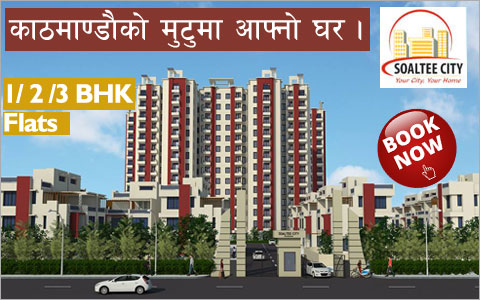|
|
|
|
|
|
|
Latest News:
Tuesday January 21, 2025
Home >> News >> National Property News
Recent Properties
Featured Properties
Property News
National News
Iron and steel products Nepal's No 1 export items

Iron and steel products, yarns, woollen carpets, readymade garments, lentils and textiles, in that order, topped the list of exports from Nepal in the first 10 months of the fiscal year.
According to the Trade and Export Promotion Centre (TEPC), the country exported iron and steel products worth Rs 8.54 billion, yarns Rs 4.64 billion, woollen carpets Rs 3.93 billion, readymade garments Rs 3.26 billion, lentils Rs 3.19 billion and textiles Rs 3.06 billion.
The export of yarns, woollen carpets, lentils and readymade garments registered a double-digit growth during the review period compared to the same period last year. Exports of iron and steel products rose 1.2 percent while textile exports plunged more than 11 percent.
Udaya Raj Pandey, president of the Garment Association Nepal (GAN), said the export performance was not satisfactory compared to past years. “The country’s manufacturing sector is still suffering from a shortage of workers and security problems,” he added.
The countrsy’s total exports amounted to Rs 52.11 billion during the review period, up 4.8 percent from last year. While exports increased marginally, imports jumped 9.8 percent to Rs 313.87 billion, leading to a 10.9 percent increase in the trade deficit, according to the TEPC.
Among imports, petroleum products registered the largest increase followed by iron and steel products. Nepal imported Rs 57.09 billion worth of oil and Rs 36.02 billion worth of iron and steel products.
Meanwhile, imports of motor vehicles and machinery parts recorded a drop. Pandey attributed the fall in the import of machinery parts to a contraction in the country’s industrial sector.
“Many factories have shut down of late which has resulted in a decline in the use of machinery parts.”Products like polythene granules, crude palm oil, chemicals and telecom equipment were also among the largest imports.
India, Bangladesh and the US were the top buyers of Nepali products this year, importing Rs 34.07 billion, Rs 3.30 billion and Rs 3.09 billion worth of goods
respectively. Exports to Turkey and Bangladesh rose the most. According to the TEPC, exports of polyester yarn to Turkey and of lentils to Bangladesh have increased significantly this year.
However, exports to China and Bhutan registered a drop. “Exports of wheat flour and vegetable ghee to China and of iron products, transformers and noodles to Bhutan declined during the period,” said Suyash Khanal, director of the Statistics Department, TEPC.
Meanwhile, India, China and Argentina were listed as the main source countries for imports. Nepal imported goods worth Rs 213.71 billion, Rs 32.31 billion
and Rs 6.71 billion respectively from these three countries. “The import of agricultural products including crude soybean oil from Argentina has increased significantly,” added Khanal.
IMPORT
Commodities FY 2009-10 FY 2010-11 Change %
Petroleum Products Rs 39.69 billion Rs 57.09 billion 43.8
Iron & Steel and products Rs 26.34 billion Rs 36.02 billion 36.8
Transport Vehicles and parts Rs 22.06 billion Rs 20.64 billion -6.5
Machinery and parts Rs 21.63 billion Rs 20.41 billion -5.6
Electronic and Electrical Rs 14.96 billion Rs 15.31 billion 2.3
Equipment
EXPORT
Commodities FY 2009-10 FY 2010-11 Change %
Iron and steel articles Rs 8.43 billion Rs 8.54 billion 1.2
Yarns Rs 3.89 billion Rs 4.64 billion 19.1
Woollen Carpet Rs 3.33 billion Rs 3.93 billion 17.5
Readymade Garments Rs 2.96 billion Rs 3.26 billion 10.1
Lentils Rs 2.86 billion Rs 3.19 billion 11.4
Textiles Rs 3.44 billion Rs 3.06 billion -11.2
Main Trading Partner Countries
EXPORT
Countries FY 2009-10 FY 2010-11 Change %
India Rs 32.76 billion Rs 34.07 billion 4.0
Bangladesh Rs 2.51 billion Rs 3.30 billion 31.5
USA Rs 3.07 billion Rs 3.09 billion 0.5
IMPORT
Countries FY 2009-10 FY 2010-11 Change %
India Rs 155.13 billion Rs 213.71 billion 37.8
China Rs 31.39 billion Rs 32.31 billion 2.9
Argentina Rs 2.83 billion Rs 6.71 billion 137.2
source: Khanal, Rajesh (2011),"Iron and steel products Nepal’s No 1 export items", The Kathmandu Post, 22 June 2011
COMMENTS
Recommendations
NATIONAL NEWS
- 9th Nepal Buildcon International Expo 2024
- Real Estate Expo 2023
- NRB raises housing loan limit to encourage home constructions
- Nepal Rastra Bank (NRB) Monetary Policy 2080-2081
- New Price of Land in Kathmandu Metropolitan City, Nepal
- Capital Gains Tax Rate on Real Estate Transactions in Nepal 2080-81 ( 2023/24 )
- Kathmandu metropolis implements free parking policy for commercial buildings and hospitals
BOOKING OPEN/OFFER
|
|
|
|
|
|
|
|
All trademarks, logo and names are properties of their respective owners. All Right Reserved.
© Copyright 2021
Housing
Nepal
.com

![[X]](https://www.housingnepal.com/images/popup-close-button.png)



















































































































































































































































































































































































































































































 Facebook
Facebook
 Delicious
Delicious
 Digg
Digg
 Reddit
Reddit
 Stumble Upon
Stumble Upon









